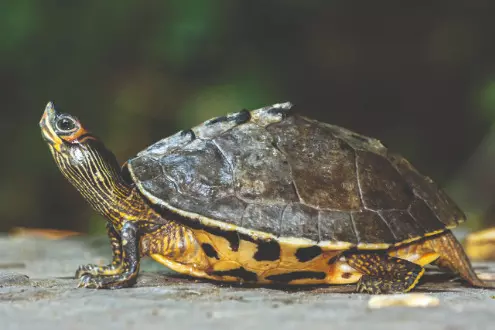Study points out substantial reduction in genetic diversity of Indian Roofed turtle

Kolkata: A recent collaborative study by researchers from India and South Korea has pointed out substantial reduction in the genetic diversity of the Indian Roofed Turtle (Pangshura tecta) across different river basins within its native range and has advocated a proper scientific intervention using a multifaceted approach of genetic and ecological insights for its protection in the wild.
The Indian Roofed Turtle is classified as ‘vulnerable’ by the IUCN Red List of threatened species, Schedule I of the Indian Wildlife (Protection) Act, 1972 and listed under Appendix I of the Convention on International Trade in Endangered Species of Wild Fauna and Flora (CITES). The reptile serves critical roles in aquatic ecosystems that contribute to key ecological processes such as food web dynamics, scavenging activity etc. It is found in the Sub-Himalayan lowlands of the Indus-Ganges-Brahmaputra-Mahanadi (IGBM) river basin and the Narmada River basin in the Indian subcontinent.
“The ensemble species distribution modelling (SDM) identified that 134,791 km² (10.83 per cent) of the IUCN-defined extent is currently suitable habitat of this species. However, projections under future climate scenarios predict a substantial reduction in suitable habitat exceeding 60 per cent with the most pronounced losses in the Narmada basin (50.86 per cent–74.77 per cent) and the Indus-Ganges Brahmaputra-Mahanadi basin (64.85 per cent–72.47 per cent).
This climate-driven contraction is likely to exacerbate habitat fragmentation, posing significant threats to the persistence of viable populations,” said Imon Abedin of Dibru-Saikhowa Conservation Society, Assam. Arunima Singh of Turtle Survival Alliance (TSA) Foundation in Lucknow pointed out that the habitat suitability assessment reveals that a mere 10.83 per cent of the total range of P. tecta is currently suitable for its survival.
“Projections indicate a loss exceeding 60 per cent of suitable habitat due to climate change, a worsening trend widely acknowledged in ecological studies. As climate variables exceed the species’ tolerance thresholds, these areas are likely to become unsuitable, resulting in range contractions, diminished population viability and potential local extirpations,” said Shailendra Singh from TSA India.
“Our study strongly advocates for the protection of riparian zones and areas in close proximity to rivers, emphasising their susceptibility to illegal activities such as silt and stone collection, which pose significant threats to freshwater turtles.
In addition, issues such as riverbank erosion, sedimentation and other anthropogenic pressures are identified as key drivers of land use and land cover changes within the IGBM River basin, both now and in the future. Therefore, it is critical that all developmental activities in these sensitive regions undergo rigorous Environmental Impact Assessments (EIA) to evaluate potential risks to these vulnerable freshwater turtle species,” said Prof Shantanu Kundu of Pukyong National University, Busan.
He added that the practice of fishing using electrocution and nylon nets must be regulated.



